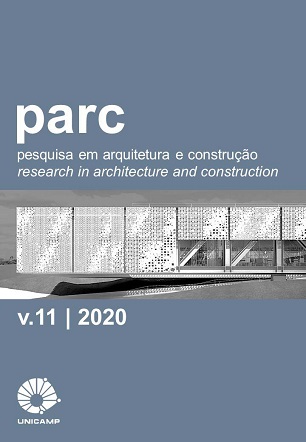Abstract
The environmental behavior of buildings has been discussed in order to integrate quantitative and qualitative aspects of energy performance into the process of preparing artificial lighting projects. The purpose of this study is to examine the capacity of the DIALux evo 8 software to evaluate, in an integrated way, the visual performance and energy efficiency of virtual models during the elaboration of residential artificial lighting projects. The outline of the study consisted of: (i) definition of visual performance and efficiency indicators for artificial lighting; (ii) verification of the potential for the elaboration of these indicators by the software; (iii) application of simulation in residential environment. The visual comfort indicators evaluated were: maintained illuminance, uniformity, unified glare rating, color rendering index and color temperature. The indicators concerning energy efficiency evaluated were: luminous efficacy and lighting power densities. The simulation aimed to promote the discussion of capacity through the metrics determined by the software and aspects related to the user interface during the analysis of visual and energy performance. It was been found that all of the proposed indicators are calculated by DIALux evo 8, however the integrated analysis provided by the software's graphical interface prioritizes the analysis of illuminances. The Unified Glare Rating and lighting power densities are presented only in the documentation, requiring comparative analyzes performed outside the program. There were limitations regarding the standards used by the software, exclusive to EN 12464-1, consequently not including residential types. The contribution of this work consists of discussing the resources offered by the software and its repercussions in the management of lighting projects.
References
ABNT - ASSOCIAÇÃO BRASILEIRA DE NORMAS TÉCNICAS. NBR 15575-1. Edificações Habitacionais. Desempenho Parte 1: Requisitos gerais Prefácio. Rio de janeiro, 2013a. 60p.
ABNT - ASSOCIAÇÃO BRASILEIRA DE NORMAS TÉCNICAS . NBR ISO/CIE 8995-1. Iluminação de ambientes de trabalho. Rio de janeiro, 2013b. 46 p.
ASHRAE - AMERICAN SOCIETY OF HEATING, REFRIGERATING AND AIR-CONDITIONING ENGINEERS. ASHRAE Standard 90.1. Energy Standard for Buildings Except Low-rise Residential Buildings. Atlanta, 2016.
ASHRAE - AMERICAN SOCIETY OF HEATING, REFRIGERATING AND AIR-CONDITIONING ENGINEERS. ASHRAE Standard 90.2. Energy-Efficient Design of Low-Rise Residential Buildings. Atlanta, 2018.
BALOCH, A. A., SHAIKH, P. H., SHAIKH, F., LEGHARI, Z. H., MIRJAT, N. H., UQAILI, M. A. Simulation tools application for artificial lighting in buildings. Renewable and Sustainable Energy Reviews, v. 82, November 2017, p. 3007–3026, 2018. Elsevier. DOI: https://doi.org/10.1016/j.rser.2017.10.035.
CEN - EUROPEAN COMMITTEE FOR STANDARDIZATION. EN 12464-1. Light and lighting - Lighting of work places. Part 1: Indoor work places. UK, 2011.
CEN - EUROPEAN COMMITTEE FOR STANDARDIZATION. CSN EN 15193-1 - Energy performance of buildings - Energy requirements for lighting - Part 1: Specifications, Module M9. UE, 2017.
CIE - COMMISSION INTERNATIONALE DE L´ECLAIRAGE. CIE 097:2005 Maintenance of indoor electric lighting systems. Vienna, Austria, 2005.
CORDEIRO, Ana Carolina Aquareli. O uso de cobogós como segunda pele em edifícios de escritórios: análise do desempenho lumínico de diferentes geometrias. 2018. Dissertação (Mestrado em Arquitetura, Urbanismo e Tecnologia) - Instituto de Arquitetura e Urbanismo, Universidade de São Paulo, São Carlos, 2018. DOI:https://doi.org/10.11606/D.102.2018.tde-25042018-103424.
DIAL GMBH. DIALux evo 7. Version history. 2017. Disponível em: https://www.dial.de/en/dialux/dialux-desktop/versionshistorie/dialux-evo-70/. Acesso em: 10 Janeiro 2019.
DIAL GMBH. DIALux evo 8. Version history. 2018. Disponível em: https://www.dial.de/en/dialux-desktop/versionhistory/dialux-evo-8/. Acesso em: 10 Janeiro 2019.
DIAL GMBH. DIALux evo manual. A collection of all wiki articles. 2019a. Disponível em: http://en.wiki.dialux.com/index.php/Main_Page. Acesso em: 10 Janeiro 2019.
DIAL GMBH. LDT Editor 1.2 Program. 2019b. Disponível em: https://www.dial.de/en/ldt-editor/. Acesso em: 10 Janeiro 2019.
DIAL GMBH. LUMsearch DIAL. The DIALux product finder. 2019c. Disponível em: https://www.dial.de/en/lumsearch/. Acesso em: 10 Janeiro 2019.
EEA - EUROPEAN ENVIRONMENT AGENCY. EEA core set of indicators. EEA Technical report No 1/2005. Copenhagen: EEA, 2005. Disponível em: https://www.eea.europa.eu/publications/technical_report_2005_1. Acesso em: 10 Maio 2014.
ELETROBRAS; UFSC. Manual de aplicação do RTQ-C. 4.1. Versão 3. Brasilia: PROCEL, 2015. Disponivel em: http://www.pbeedifica.com.br/sites/default/files/projetos/etiquetagem/comercial/downloads/manual_rtqc2016.pdf. Acesso em: 10 Agosto 2017.
ELETROBRAS; UFSC. Manual para Aplicação do RTQ-R. 4.2. Brasilia: PROCEL, 2014. Disponível em: http://www.pbeedifica.com.br/sites/default/files/projetos/etiquetagem/residencial/downloads/Manual_de_aplica%C3%A7%C3%A3o_do_%20RTQ-R-v01.pdf. Acesso em: 10 Agosto 2017.
FRAMPTON, K. Studies in tectonic culture: The poetics of construction in nineteenth and twentieth century architecture. Cambridge: MIT PRESS, 1995, 430 p.
GRONDZIK, W. T.; KWOK, A. G. O processo de projeto. In: Manual de Arquitetura Ecologica. Porto Alegre: Bookman, 2013.
IES - ILLUMINATING ENGINEERING SOCIETY. The Lighting Handbook - 10th Edition. New York: IES, 2011.
KAEMPF, J.; PAULE, B. Lighting retrofit in current practice Evaluation of an international survey Switzerland: IEA Solar Heating and Cooling Programme, 2016. (Technical Report of Subtask T50-C1)
MESHKOVA, T. V.; BUDAK, V. P. Dialux 4.10 and DIALux evo - Main Differences. Light & Engineering, v. 21, n. 4, p. 58–63, 2013. ISSN 0236-2945.
MINISTÉRIO DE FOMENTO. Código Técnico de la Edificación de España. Documento Básico DB-HE. Ahorro de Energía. BOLETÍN OFICIAL DEL ESTADO, p. 67137 – 67209. Madrid, 2013.
MONEDERO, J. Simulación visual de la iluminación. Teoría. Técnicas. Análisis de casos. Barcelona: Oficina de Publicacions Acadèmiques Digitals de la UPC, 2015.
MORAES, Júlia Silva de; MUROS ALCOJOR, Adrián; BITTENCOURT, Leonardo Salazar. Análise de indicadores de desempenho da iluminação artificial em ambientes residenciais. PARC Pesquisa em Arquitetura e Construção, Campinas, SP, v. 9, n. 1, p. 35-46, mar. 2018. ISSN 1980-6809. DOI: https://doi.org/10.20396/parc.v9i1.8650219.
MOURA, Mariangela. Iluminação: Análise de cenários utilizando a tecnologia led. 2015. Tese (Programa de Pós-Graduação em Engenharia Civil) – Universidade Federal Fluminense, Rio de Janeiro, 2015. Disponível em: http://www.poscivil.uff.br/conteudo/iluminacao-analise-de-cenarios-utilizando-tecnologia-led. Acesso em: 10 Janeiro 2017.
OXMAN, R. Digital architecture as a challenge for design pedagogy: theory, knowledge, models and medium. Design Studies, v. 29, n. 2, p. 99–120, 2008. DOI: https://doi.org/10.1016/j.destud.2007.12.003.
OXMAN, R. Theory and design in the first digital age. Design Studies, v. 27, n. 3, p. 229–265, 2006. DOI: https://doi.org/10.1016/j.destud.2005.11.002.
OXMAN, R. Thinking difference: Theories and models of parametric design thinking. Design Studies, v. 52, p. 4–39, 2017. DOI: https://doi.org/10.1016/j.destud.2017.06.001.

This work is licensed under a Creative Commons Attribution 4.0 International License.
Copyright (c) 2020 PARC Research in Architecture and Building Construction


